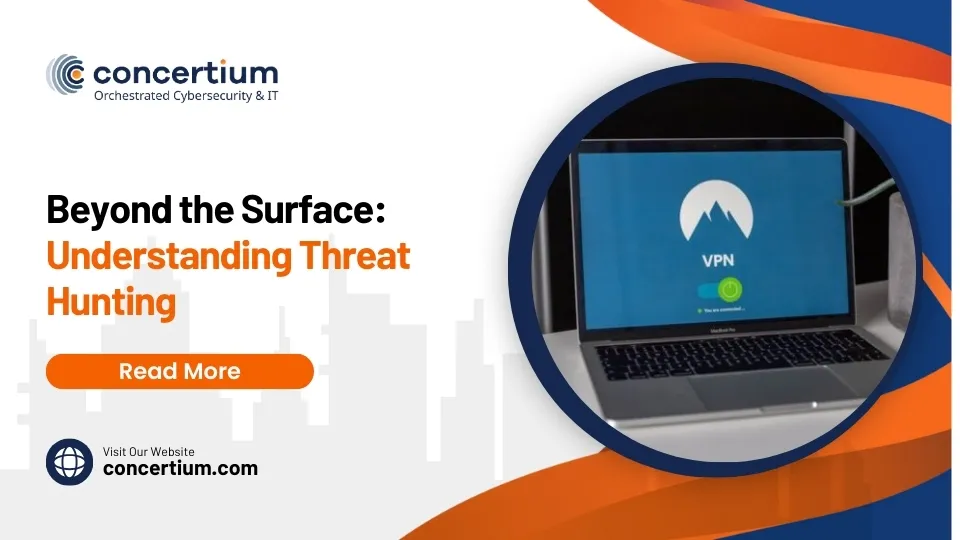Threat hunting definition is all about proactively seeking out and identifying cyber threats that may be lurking unnoticed within your organization’s network. It’s like being a cyber detective, looking for clues of hidden dangers before they cause harm. The process combines digital forensics and incident response methods to identify unknown and ongoing threats. By doing so, it aims to catch potential issues early—ideally before they impact your business.
In today’s digital landscape, cyber threats are ever-present and constantly evolving. Proactive cybersecurity approaches like threat hunting are crucial in staying ahead of these threats. Unlike traditional methods that wait for an attack to occur, threat hunting actively searches for vulnerabilities and signs of compromise. It lowers the risk by improving the accuracy of threat detection and enabling early mitigation.
Understanding and implementing effective threat detection strategies can safeguard your enterprise’s valuable data and maintain customer trust. For businesses with limited in-house expertise, partnering with cybersecurity experts such as those at Concertium can provide the necessary support to protect sensitive information without disrupting daily operations.
Threat Hunting Definition
Cyber threat hunting is a proactive search for hidden threats within an organization’s network. Think of it as a digital treasure hunt, but instead of gold, you’re looking for potential cyber threats that could harm your business.
Unlike traditional security measures that react to known threats, threat hunting is all about finding the unknown. It’s a bit like looking for a needle in a haystack, but with the right tools and expertise, that needle becomes much easier to find.
The key to effective threat hunting is proactive search. This means not waiting for alarms to go off or for data breaches to occur. Instead, threat hunters actively seek out vulnerabilities and signs of compromise. They use a combination of digital forensics, incident response, and threat intelligence to spot these hidden dangers.
Why is this important? Because cyber threats are constantly evolving. Attackers are always finding new ways to bypass traditional defenses. By engaging in threat hunting, organizations can stay one step ahead, identifying and neutralizing threats before they have a chance to cause damage.
Threat hunting is like having a security guard who doesn’t just watch the gates but also patrols the grounds, looking for any signs of trouble. It’s a criti
cal component of a robust cybersecurity strategy, ensuring that your organization is not only protected from known threats
but also from those lurking in the shadows.
Key Strategies and Methodologies
When it comes to threat hunting, understanding the strategies and methodologies is crucial. These approaches help security teams find and neutralize threats before they can cause harm. Let’s break down some of the key methods used in this proactive cybersecurity practice.
Structured Hunting
Structured hunting involves using known indicators of attack (IoAs) and the tactics, techniques, and procedures (TTPs) of cyber threat actors. This method aligns hunts with established frameworks like MITRE ATT&CK. By doing so, threat hunters can anticipate potential threats and take action before damage occurs. It’s like having a map that guides hunters to potential hotspots of cyber activity.
Unstructured Hunting
In contrast, unstructured hunting starts with a trigger, often an indicator of compromise (IoC). This trigger prompts analysts to explore patterns and anomalies in network data. Imagine it as following breadcrumbs left behind by cyber intruders. While less predictable than structured hunting, it allows hunters to uncover threats that might not fit standard profiles.
Situational and Entity-Driven Hunting
Situational hunting focuses on specific risks identified within an organization’s IT landscape. It often arises from internal risk assessments or trending vulnerabilities. On the other hand, entity-driven hunting uses aggregated attack data to spot current cyber TTPs. Both methods are custom to an organization’s unique environment, making them highly effective in detecting sophisticated threats.
Hypothesis-Based Hunting
Hypothesis-based hunting is all about forming educated guesses based on known attack patterns. Analysts create hypotheses about how an attacker might infiltrate a network. These hypotheses guide the search for evidence of such activities. This approach is akin to a detective piecing together a crime from clues, enabling teams to stop threats before they escalate.
Intel-Based Hunting
Lastly, intel-based hunting leverages threat intelligence to guide hunts. This method involves analyzing data about current and emerging threats. By understanding what attackers are up to, security teams can preemptively search for signs of these activities within their networks. It’s like having insider knowledge of the enemy’s playbook, offering a tactical advantage in the cyber defense game.
In summary, these strategies and methodologies form the backbone of effective threat hunting. They enable organizations to proactively detect and mitigate security risks, staying one step ahead of cyber adversaries. In the next section, we’ll dive into the tools and techniques that make these hunting methodologies possible.
Tools and Techniques
To effectively pursue cyber threat hunting, organizations rely on a suite of advanced tools and technologies. These tools not only help identify threats but also enable security teams to respond rapidly and effectively. Let’s explore some of the key components that power modern threat hunting.
Security Information and Event Management (SIEM)
SIEM systems are the backbone of many cybersecurity operations. They aggregate and analyze security data from across an organization’s network, providing a centralized view of security events. By using advanced analytics and correlation rules, SIEM tools can identify patterns and anomalies that may indicate a threat.
- Data Aggregation: SIEM collects data from various sources for a comprehensive security overview.
- Real-Time Monitoring: It offers real-time alerts and reporting for swift threat detection.
Endpoint Detection and Response (EDR)
EDR solutions focus on monitoring endpoint devices like laptops and servers. They offer real-time visibility into endpoint activities and can quickly detect and respond to threats that bypass traditional security measures.
- Improved Security: EDR continuously monitors endpoints to detect threats.
- Comprehensive Detection: Capable of identifying malware, ransomware, and unauthorized access.
Extended Detection and Response (XDR)
XDR takes threat detection a step further by integrating multiple security products into a unified platform. It extends beyond endpoints to include network and cloud data, providing a holistic view of security threats.
- Integrated Approach: Combines data from various sources for a more comprehensive threat analysis.
- Improved Response: Enables faster and more coordinated responses to complex threats.
Machine Learning and Artificial Intelligence
Machine learning (ML) and artificial intelligence (AI) are revolutionizing threat detection. These technologies can process vast amounts of data to identify anomalies and predict potential threats.
- Advanced Analytics: ML and AI algorithms analyze data to spot unusual patterns.
- Predictive Capabilities: They can forecast potential threats, allowing proactive measures.
Security Analytics
Security analytics tools use big data and sophisticated algorithms to deliver insights into security threats. By presenting data through easy-to-understand graphs and charts, these tools simplify the detection of correlations and patterns.
- Detailed Observability: Provides visual representations of threat data for easier analysis.
- Accelerated Hunting: Speeds up the identification and investigation of threats.
These tools and techniques form the foundation of effective threat hunting. They empower security teams to not only detect threats but also respond promptly and efficiently, ensuring robust protection for their organizations. In the next section, we will dig into the types of threats these tools help to detect.
Types of Threats Detected
In the field of cyber threat hunting, understanding the types of threats that can be detected is crucial. Let’s break down some common threats that threat hunters focus on.
Malware
Malware is a broad term that encompasses various malicious software like viruses, ransomware, and spyware. These programs can disrupt operations by stealing data, encrypting files, or causing system failures. Threat hunters use tools like EDR and SIEM to detect unusual patterns that indicate malware presence.
- Examples: Phishing attacks, adware, trojans.
- Detection: Anomalous network traffic, unexpected file changes.
Insider Threats
Insider threats are security risks originating from within the organization. These can be malicious insiders with harmful intent or compromised insiders who unknowingly aid external attackers. Such threats are hard to detect because they involve legitimate access.
- Types:
- Malicious Insiders: Intentionally harm the organization for personal gain.
- Compromised Insiders: Employees whose credentials are hijacked by attackers.
- Third-Party Insiders: Vendors or partners with access to systems.
- Detection: Monitoring user behavior for anomalies, using machine learning to spot deviations from regular patterns.
Advanced Persistent Threats (APTs)
APTs are sophisticated, long-term attacks conducted by skilled adversaries. These attackers infiltrate networks and remain undetected while gathering intelligence or exfiltrating data.
- Characteristics:
- Stealthy: Avoid detection by blending with normal network traffic.
- Persistent: Maintain access over extended periods.
- Detection: Analyzing network traffic and endpoint data for subtle indicators of compromise.
Social Engineering Attacks
Social engineering attacks exploit human psychology to trick individuals into revealing confidential information. Common tactics include phishing emails and baiting.
- Examples: Phishing, scareware.
- Prevention: Employee training to recognize suspicious communications, implementing multi-factor authentication.
By employing a combination of proactive search methods and advanced tools, threat hunters can identify and mitigate these threats before they cause significant harm. This proactive approach is essential in maintaining a secure organizational environment. In the following section, we will address frequently asked questions about threat hunting.
Frequently Asked Questions about Threat Hunting
What is the primary goal of threat hunting?
The primary goal of threat hunting is to proactively detect threats before they can cause harm. Unlike traditional methods that wait for alerts, threat hunting involves actively searching for hidden threats. This approach helps in anomaly investigation, where unusual patterns are analyzed to uncover potential security risks.
What is the difference between threat hunting and SOC analyst?
A Security Operations Center (SOC) analyst typically focuses on monitoring and responding to alerts generated by security tools. This is a reactive approach. In contrast, threat hunting is a proactive process. Threat hunters don’t wait for alerts; they seek out threats using their expertise and available data. While SOC analysts provide critical support by addressing immediate threats, threat hunters look deeper to uncover threats that might not trigger alerts.
What is threat hunting vs monitoring?
Threat hunting and monitoring are both crucial, but they serve different purposes. Monitoring is part of a comprehensive strategy that involves keeping an eye on systems to spot known threats. It’s like having a security camera that triggers when it detects motion. Threat hunting goes beyond this by searching for hidden threats that might evade regular monitoring systems. Hunters use insights from monitoring to form hypotheses and investigate further, ensuring threats are identified and addressed before they escalate.
By understanding these aspects of threat hunting, organizations can improve their security posture and better protect their assets. In the next section, we will explore the tools and techniques used in threat hunting.
Conclusion
At Concertium, we understand that cybersecurity is not a one-size-fits-all solution. That’s why we focus on providing custom solutions tailored to each client’s unique needs. Our nearly 30 years of expertise in the industry have taught us that every business faces different challenges, and we are here to address them head-on.
Our cybersecurity services are designed to offer comprehensive protection without disrupting your business operations. We leverage our unique Collective Coverage Suite (3CS), which includes AI-improved observability and automated threat eradication. This means we can detect and neutralize threats faster, giving you peace of mind.
In today’s rapidly evolving digital landscape, having a proactive approach to cybersecurity is crucial. Threat hunting is a key component of this strategy, allowing us to identify threats that traditional methods might miss. By partnering with us, you’re not just investing in cybersecurity; you’re investing in the safety and future of your business.
Explore how our proactive threat hunting services can help your business stay secure and thrive. Let us be your trusted partner in navigating the complexities of cybersecurity.





